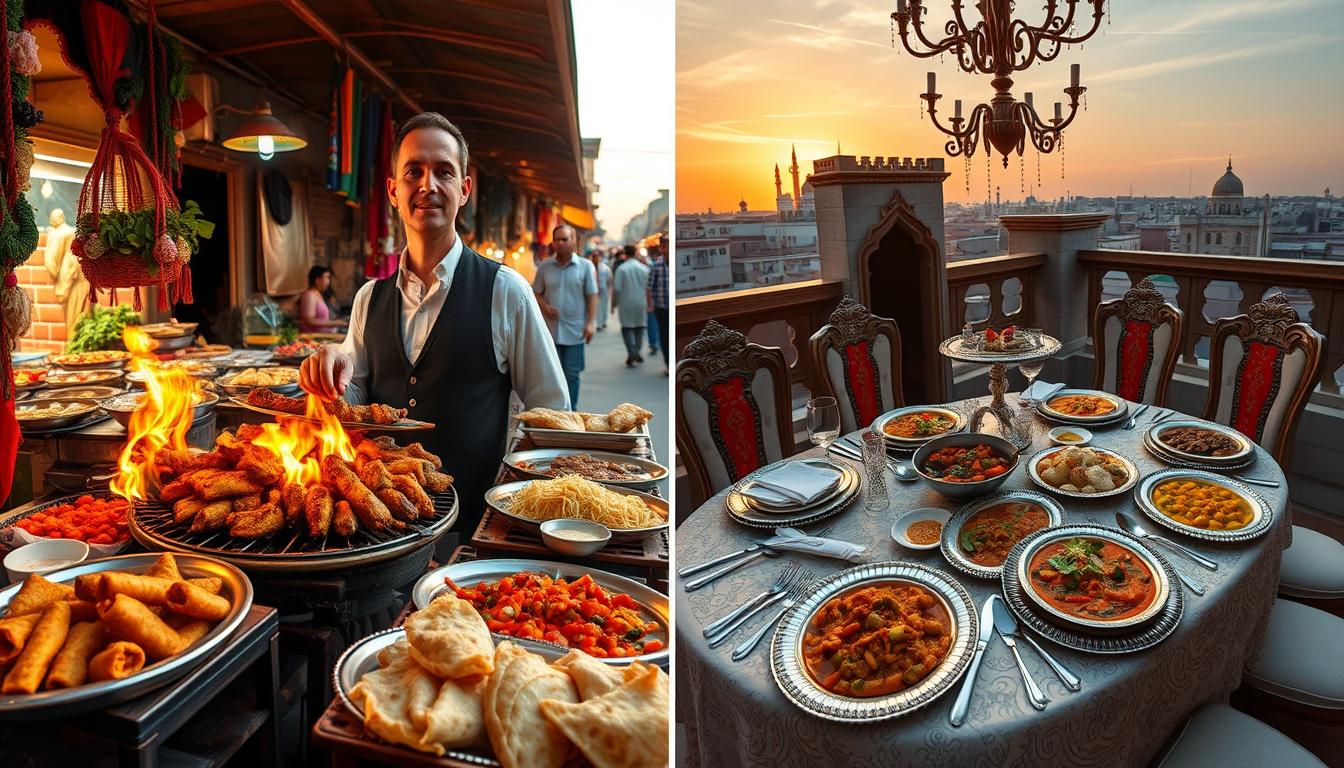Pakistan’s food scene is a colorful mix of different tastes. It ranges from the rich biryanis and curries of royal courts to the tasty kebabs and cool lassi found on street corners. This journey through Pakistan’s food culture shows a long history of flavors, blending local and global tastes.
Key Takeaways
- Pakistan’s cuisine is a mosaic of diverse culinary influences, from royal court dishes to street food delights.
- Signature dishes like biryani, kebabs, curries, haleem, and nihari showcase the country’s rich culinary heritage.
- Traditional cooking techniques, such as tandoori ovens and slow-cooking methods, lend unique flavors to Pakistani cuisine.
- Festivals and cultural celebrations are often marked by the enjoyment of iconic Pakistani delicacies.
- Modern interpretations and fusion cuisine are adding contemporary twists to classic Pakistani recipes.
Culinary Journey Through Pakistan
Pakistan’s food scene is a mix of many flavors, thanks to its long history and strategic location. The country’s cuisine is influenced by the Mughal Empire, spice trade routes, and local farming. This blend of cultures has created a unique taste of Pakistani food.
Diverse Influences on Pakistani Cuisine
The Mughal Empire ruled for over 300 years, leaving a big mark on Pakistani food. Dishes like biryani and qorma show their love for bold tastes and detailed cooking. The Silk Road trade brought in spices like tamarind and saffron, making them key to Pakistani cooking.
Regional Specialties and Staple Dishes
Pakistan’s different areas have their own food traditions. In Khyber Pakhtunkhwa, the nihari stew is a favorite, with slow-cooked meat and spices. Balochistan is known for its Balochi biryani, with saffron, cinnamon, and cardamom.
Across the country, you’ll find dal (lentils), roti (flatbread), and gosht (meat curries). These dishes show the skill in making simple yet tasty food.
| Regional Dish | Province | Key Ingredients |
|---|---|---|
| Nihari | Khyber Pakhtunkhwa | Slow-cooked meat, aromatic spices |
| Balochi Biryani | Balochistan | Saffron, cinnamon, cardamom, rice |
| Dal | Nationwide | Lentils, spices, herbs |
| Roti | Nationwide | Wheat flour, water |
| Gosht | Nationwide | Meat, spices, herbs, yogurt |
Pakistan’s food, from nihari to Balochi biryani, shows its rich history and diverse tastes. This variety makes Pakistani cuisine truly special.
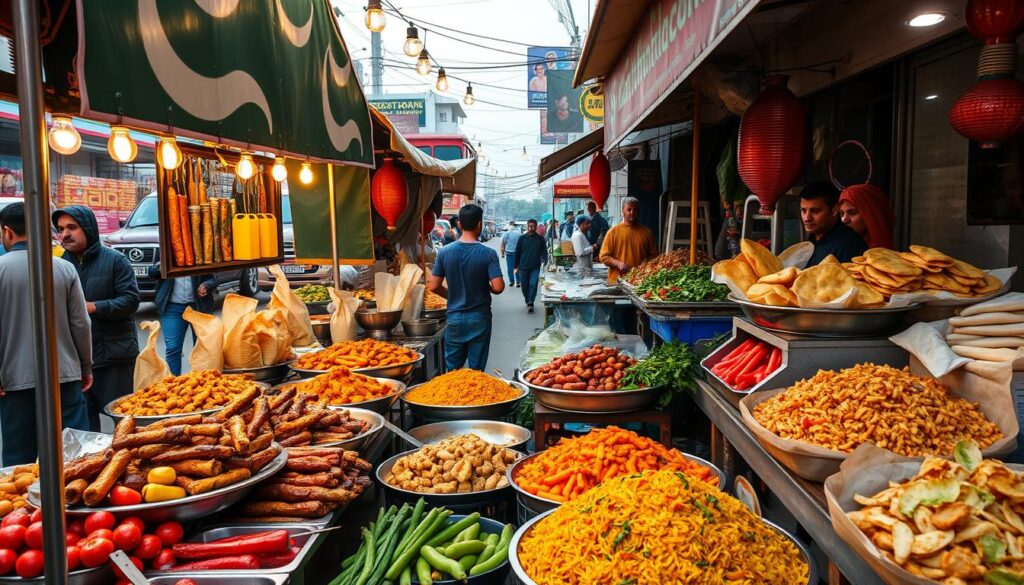
Street Food Delights
The streets of Pakistan are alive with Pakistani street food culture. You’ll find everything from hot kebabs to crunchy samosas. These dishes excite everyone who tries them.
Sizzling Kebabs and Samosas
Seekh kebabs are juicy and full of flavor. Chapli kebabs are spicy and grilled to perfection. Street vendors make them.
Samosas are a favorite too. They’re crispy on the outside and soft inside. They’re filled with spices that make your taste buds dance.
Refreshing Lassi and Falooda
When it’s hot, lassi is the perfect drink. It’s a cool yogurt drink with spices. It’s refreshing and delicious.
Falooda is a sweet treat. It’s vermicelli noodles, rose syrup, and ice cream. It’s a refreshing dessert.
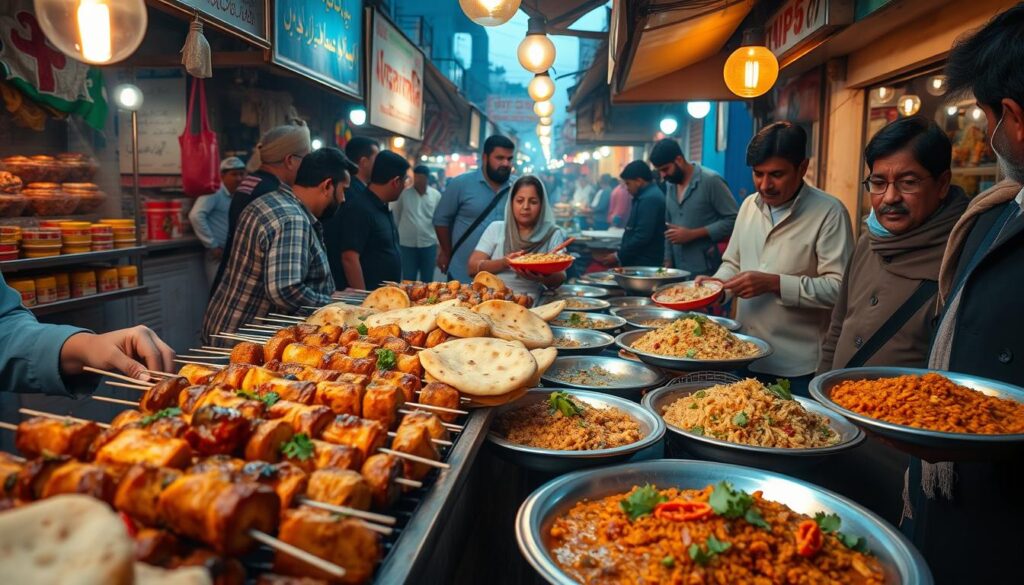
“Street food in Pakistan is not just a culinary experience, but a cultural one – a tapestry of flavors that reflects the diversity and vibrancy of the nation.”
Royal Cuisine Fit for Kings
Pakistan’s royal courts have left a lasting impact on its food. Dishes like biryani and curries are still loved today. These dishes show Pakistani chefs’ skill in mixing ingredients for unforgettable meals.
Aromatic Biryani and Flavorful Curries
The biryani is a key dish in Pakistani royal cuisine. It’s made with layers of rice, spices, and meat or vegetables. This dish was once for kings but now everyone enjoys it, showing Pakistan’s rich food history.
The curries in Pakistani food are also famous. They are rich, spiced, and slow-cooked. Each region has its own curry style, from creamy korma to spicy vindaloo. These curries highlight the complexity of Pakistani royal cuisine.
“The beauty of Pakistani royal cuisine lies in its ability to transport you to a bygone era of opulence and grandeur, where every bite is a celebration of the country’s rich cultural heritage.”
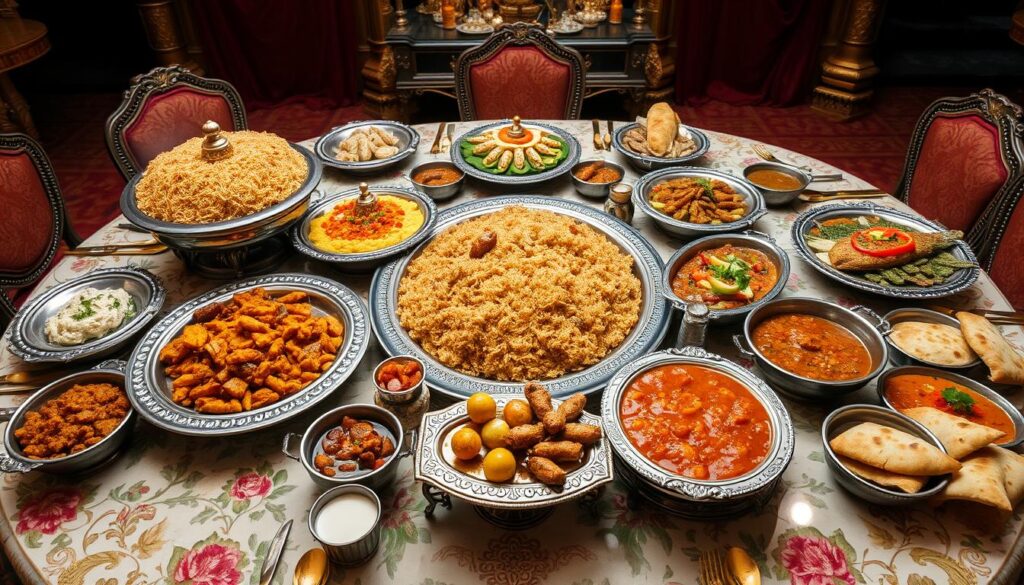
Pakistan Cuisines: A Melting Pot of Flavors
Pakistani cuisine is a mix of many flavors, showing the country’s place at the crossroads of cultures. It combines spices, herbs, and cooking methods from the Middle East, Central Asia, and India. This mix creates a unique and distinctly Pakistani culinary scene.
This blend of influences has made Pakistani food culture vibrant and inspiring. It ranges from the aromatic biryanis of the north to the spicy curries of the south. The use of spices like cumin, coriander, and cardamom, along with slow-cooking, makes Pakistani food stand out.
At the core of Pakistani cuisine is a deep respect for tradition and a focus on fresh ingredients. Whether it’s the juicy kebabs in Lahore or the rich haleem during Ramadan, each dish shares a story of the country’s rich heritage and the creativity of its people.
As a culinary melting pot, Pakistani cuisine combines East and West flavors, offering a unique dining experience. From the diverse flavors of regional dishes to the timeless elegance of royal ones, Pakistani cuisine delights and inspires food lovers globally.
Traditional Cooking Techniques
Pakistan’s rich culinary heritage is rooted in traditional cooking methods. These methods have been passed down through generations. The use of the tandoor, a clay oven, is a key technique.
Tandoori Ovens and Slow-Cooked Delicacies
The tandoor is a key part of many Pakistani kitchens. It’s used to bake naan bread and cook tandoori chicken. The clay oven’s heat sears the outside, while slow cooking melds flavors together.
Slow-cooked dishes like haleem and nihari are also important. They’re cooked for hours. This allows the spices and aromatics to infuse the meat, making it tender.
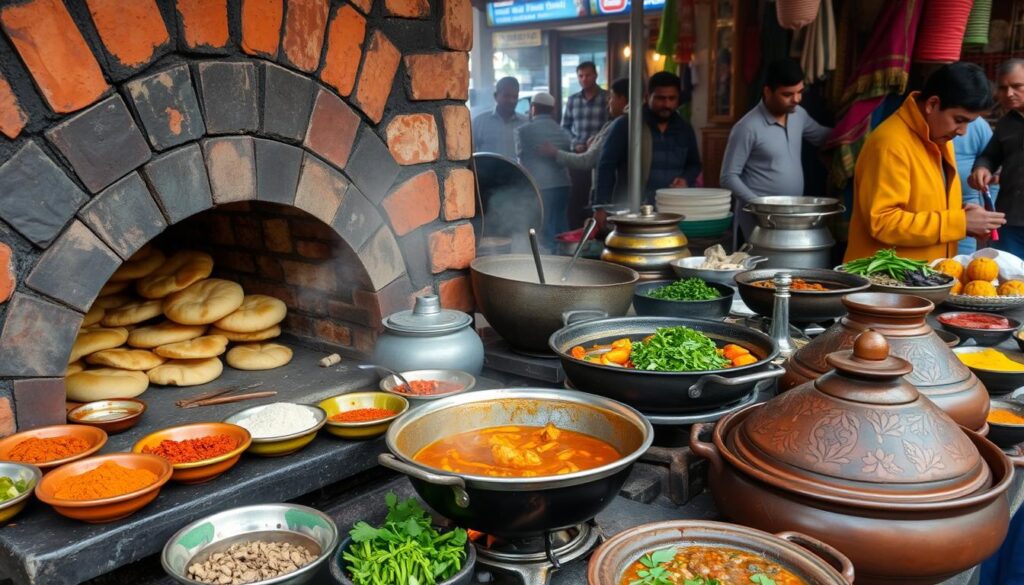
“The art of slow-cooking in Pakistani cuisine is a testament to the patience and dedication of its culinary masters, who have perfected the balance of spices and the transformation of humble ingredients into culinary masterpieces.”
These traditional cooking techniques are a big part of Pakistan’s diverse and flavorful cuisines. They captivate the senses of both local and global food lovers.
Celebrating Festivals with Food
In Pakistani culture, food is key in celebrating festivals. It’s a big part of Eid and Ramadan. These traditions show how food connects Pakistani heritage to its rich food history.
Eid Delicacies
During Eid, Pakistan’s Muslims enjoy special dishes passed down through generations. The favorite is mutton biryani, a rice dish with meat and spices. The sweet seviyan dessert adds a special touch to the celebrations.
Ramadan Specialties
Ramadan brings special iftar dishes to break the fast. Samosas and pakoras are favorites, with their crispy taste. These dishes feed both body and soul, showing the strong link between food, Eid, and Ramadan.
“Food is the heart and soul of Pakistani culture, and it’s during our festivals that this connection truly shines.”
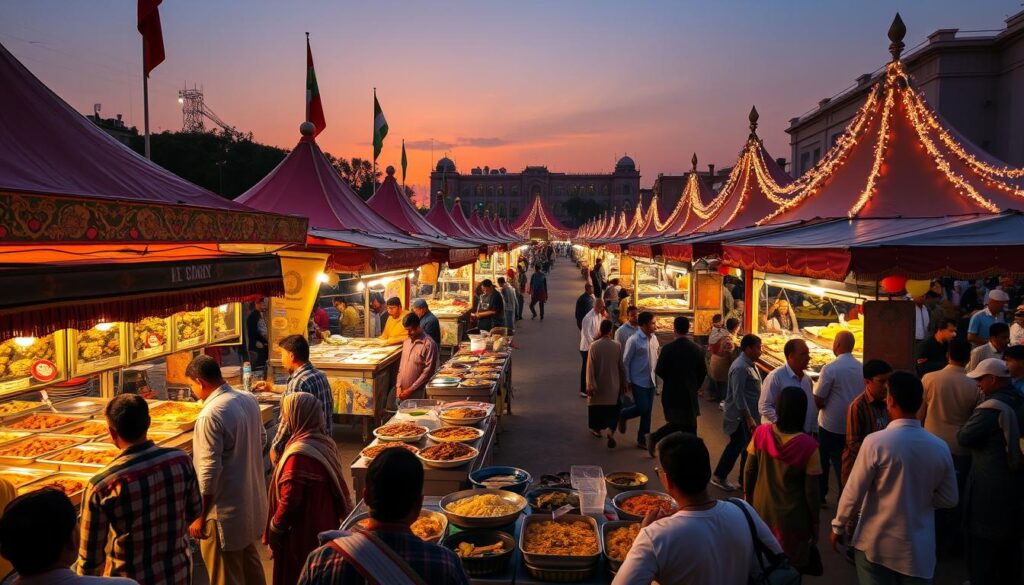
Authentic Pakistani Ingredients
Pakistani food is known for its rich flavors. This comes from the country’s wide variety of ingredients. Spices like cumin, coriander, cardamom, and chili peppers are key. They add depth to many dishes.
Lentils, or dal, are a main protein. Fresh produce like tomatoes, onions, and greens are also crucial. They make salads and garnishes vibrant. The mix of these Pakistani ingredients makes the food special.
Spices, Lentils, and Fresh Produce
At the core of Pakistani cooking are aromatic spices. Cumin, coriander, and cardamom flavor curries and biryanis. Chili peppers add a spicy touch to marinades and chutneys.
Lentils, or lentils, are a key protein. They’re used in stews and side dishes. Fresh produce like tomatoes, onions, and greens are vital. They’re used in salads, garnishes, and traditional dishes.
| Spice | Culinary Uses |
|---|---|
| Cumin | Curries, Biryanis, Marinades |
| Coriander | Curries, Chutneys, Garnishes |
| Cardamom | Biryanis, Desserts, Beverages |
| Chili Peppers | Curries, Chutneys, Marinades |
The mix of these Pakistani ingredients makes the cuisine unique. It shows the country’s rich culinary heritage.
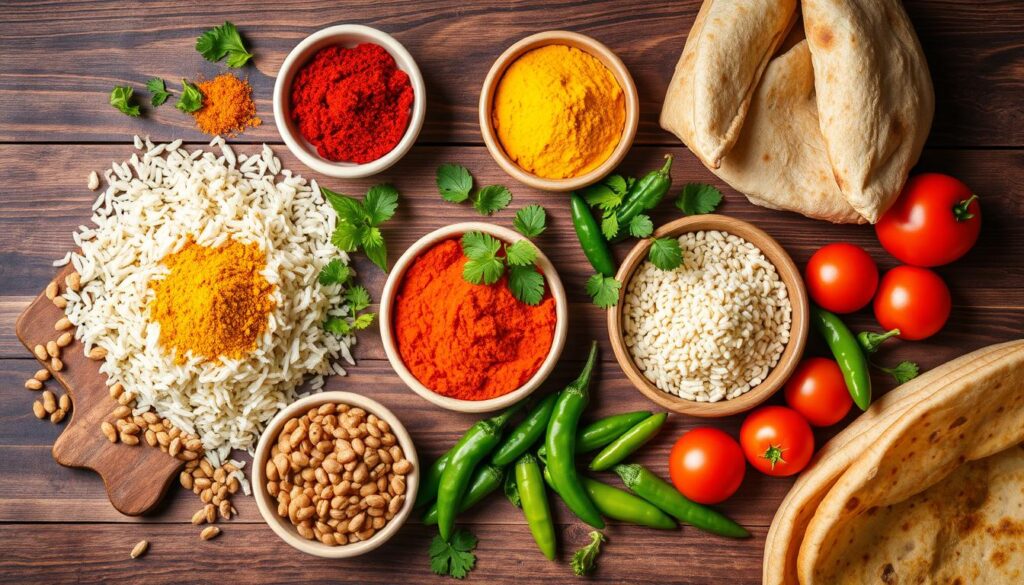
Haleem and Nihari: Iconic Dishes
In the rich tapestry of Pakistani iconic dishes, two standout culinary creations captivate the senses: haleem and nihari. These iconic dishes have become synonymous with the essence of Pakistani cuisine. They showcase the country’s mastery of slow-cooked, complex preparations.
Haleem is a hearty stew that combines slow-cooked meat, lentils, and aromatic spices. The result is a comforting and deeply flavorful dish that warms the soul. The lengthy cooking process, which can take hours or even days, allows the flavors to meld and the ingredients to melt into a harmonious blend, creating a truly sumptuous experience.
On the other hand, nihari is a slow-braised meat curry with origins in the royal kitchens of the Mughal era. This dish showcases the exceptional culinary skill of Pakistani chefs. They meticulously prepare the tender meat and create a rich, velvety sauce that captivates the palate. The slow-simmering process ensures that the flavors are deeply developed, making each bite a testament to the country’s culinary heritage.
“Both haleem and nihari are beloved dishes that have become integral to the fabric of Pakistani cuisine. They reflect the country’s diverse cultural influences and mastery of long-simmered, complex preparations.”
These iconic Pakistani iconic dishes not only delight the senses but also serve as a testament to the country’s rich culinary traditions. Whether savored in bustling street stalls or refined dining establishments, haleem and nihari continue to captivate and inspire food enthusiasts from around the world.
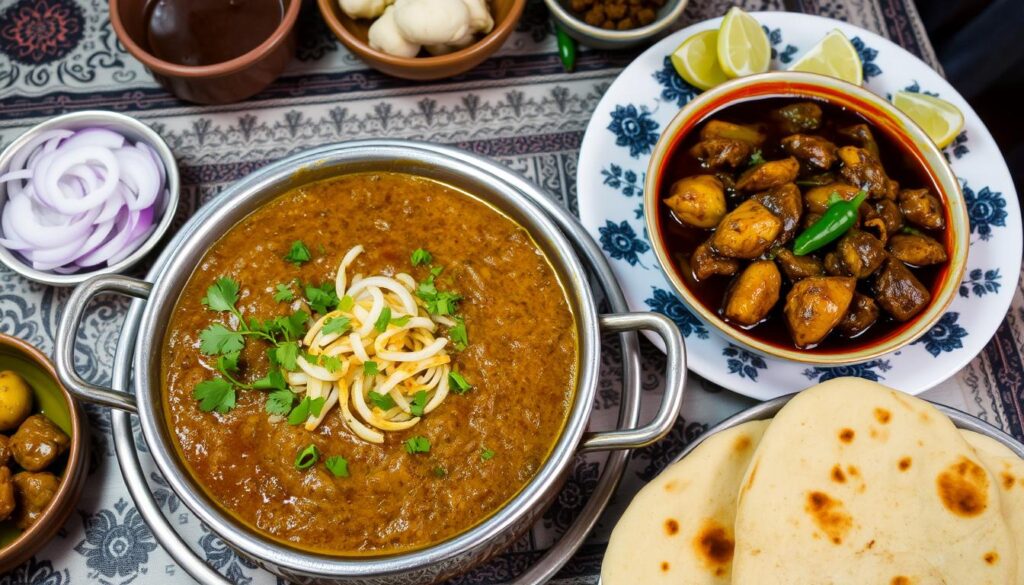
Dining Etiquette and Hospitality
Pakistani cuisine is not just about food. It’s also about cultural traditions and etiquette. Pakistani dining etiquette is deeply rooted in the country’s rich heritage. Sharing a meal is not just about eating but also about building social connections.
Guests are greeted warmly and invited to the table. They are encouraged to eat with their hands, a cherished part of Pakistani hospitality. Pakistani hosts take pride in offering many dishes. They want their guests to be well-fed and satisfied, showing the country’s renowned hospitality.
“Eating with your hands is not just a practical way of enjoying the food, but it is also a deeply symbolic act that connects you to the cultural traditions of Pakistan.”
Sharing a meal in Pakistan shows the country’s commitment to meaningful relationships and community. Whether it’s enjoying aromatic biryani or refreshing lassi, every meal is memorable. The Pakistani dining etiquette and hospitality make every meal special.
| Pakistani Dining Etiquette | Importance of Hospitality |
|---|---|
|
|
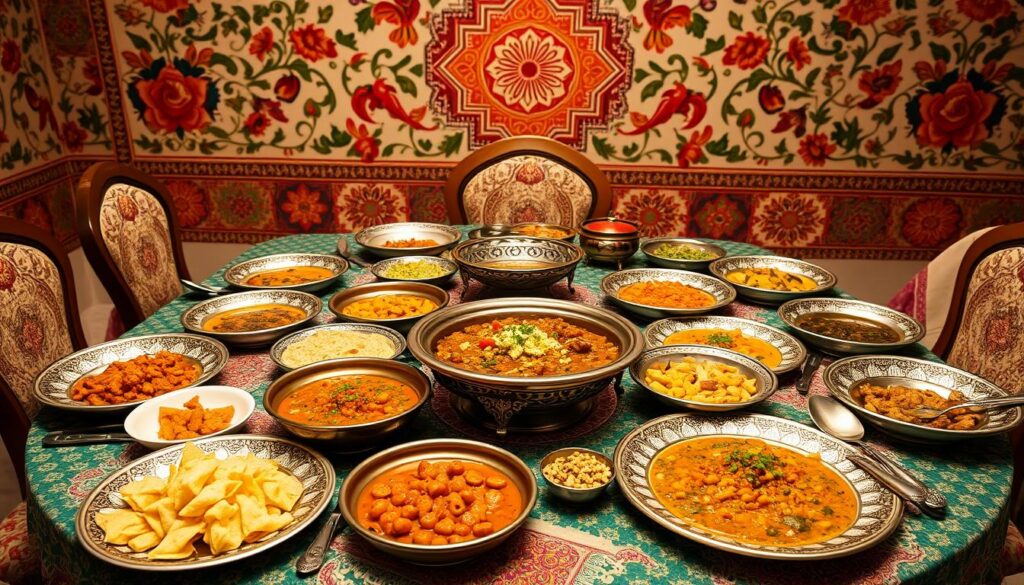
The Pakistani dining etiquette and hospitality traditions show the country’s cultural values. Sharing a meal is not just about eating. It’s about nurturing relationships and creating a sense of community.
Modern Twists on Classic Recipes
Traditional Pakistani dishes still win over many. But, a new wave of chefs and entrepreneurs are adding their own twist. They mix Pakistani flavors with global tastes, creating fusion dishes. They also give new life to old favorites with contemporary interpretations.
Fusion Cuisine and Contemporary Interpretations
This change keeps Pakistani cuisine fresh and exciting. It’s a source of pride and joy for many. Modern takes on biryani and kebabs offer new tastes and looks that wow diners.
“Pakistani cuisine has always been a melting pot of diverse cultural influences, and now a new wave of chefs is taking that tradition to exciting new heights,” says renowned food critic, Amina Malik.
By mixing old ways with new trends, these fusion dishes and modern interpretations of Pakistani cuisine are winning hearts. They show the world Pakistan’s vibrant and innovative food scene.
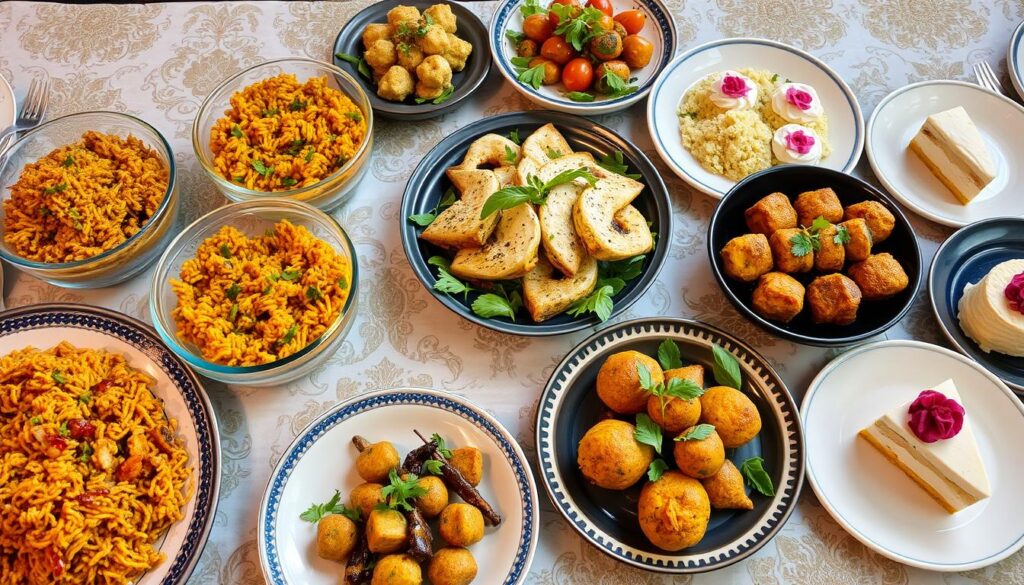
Conclusion
Pakistan is a land full of flavors, techniques, and traditions. From street food to royal dishes, Pakistani cuisine is a mix of spices and cooking methods. It has won the hearts of food lovers around the world.
The culinary diversity in Pakistan shows its deep cultural roots. It combines ancient traditions, regional flavors, and global trends. This mix creates a unique and exciting food culture.
As Pakistani cuisine changes, it keeps its roots strong. It stays connected to the land, people, and their love for food. This connection is key to its identity.
Pakistani dishes, like kebabs and lassi, take you on a flavor journey. They show the country’s rich culinary traditions. As more people try Pakistani food, they discover its amazing culinary diversity.
- Culinary Journey Through Pakistan
- Street Food Delights
- Royal Cuisine Fit for Kings
- Pakistan Cuisines: A Melting Pot of Flavors
- Traditional Cooking Techniques
- Celebrating Festivals with Food
- Authentic Pakistani Ingredients
- Haleem and Nihari: Iconic Dishes
- Dining Etiquette and Hospitality
- Modern Twists on Classic Recipes
- Conclusion
